Serving 660 students in grades 6-12, Summit Denali Charter School ranks in the top 10% of all schools in California for overall test scores (math proficiency is top 10%, and reading proficiency is top 20%).
The percentage of students achieving proficiency in math was 67% (which was higher than the California state average of 39%). The percentage of students achieving proficiency in reading/language arts was 73% (which was higher than the California state average of 50%).
The student:teacher ratio of 21:1 was equal to the California state level of 21:1.
Minority enrollment was 74% of the student body (majority Hispanic), which was lower than the California state average of 80% (majority Hispanic).
School Overview
School Type
Grades Offered
Grades 6-12
Total Students
660 students
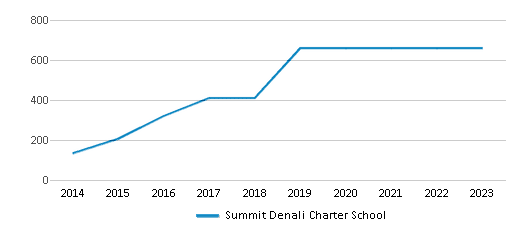
Gender %
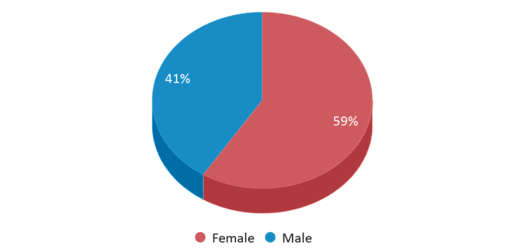
Total Classroom Teachers
31 teachers
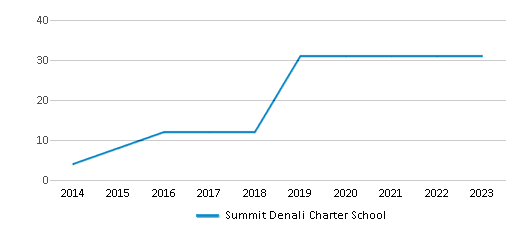
Students by Grade
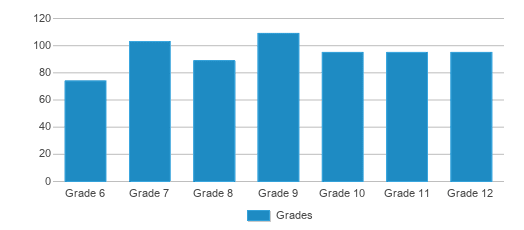
School Calendar
School Rankings
Math Test Scores (% Proficient)
(17-18)67%
39%
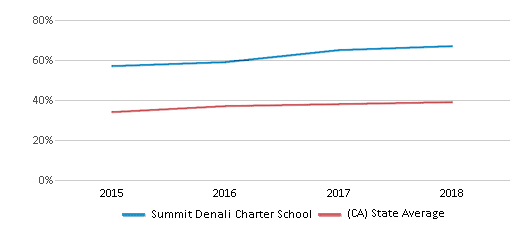
Reading/Language Arts Test Scores (% Proficient)
(17-18)73%
50%
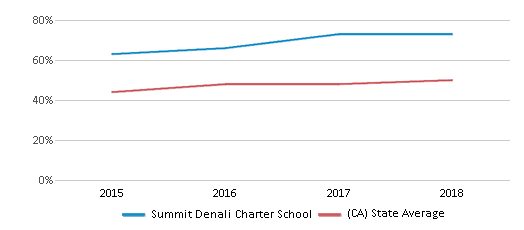
Student : Teacher Ratio
21:1
21:1
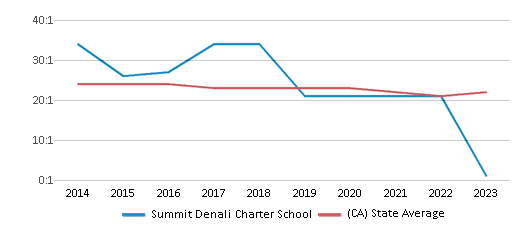
American Indian
3%
1%
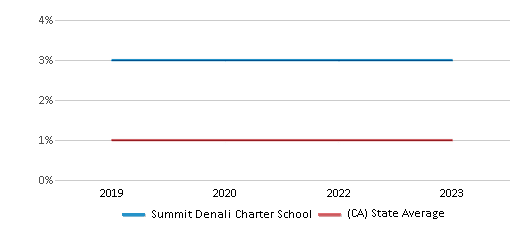
Asian
17%
12%
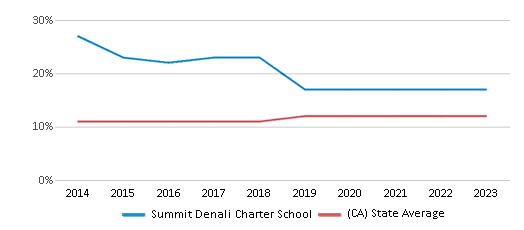
Hispanic
24%
56%
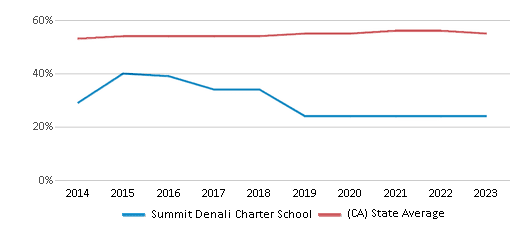
Black
3%
5%
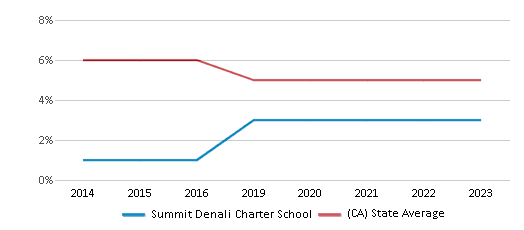
White
26%
20%
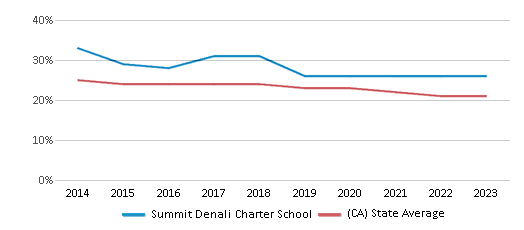
Hawaiian
2%
n/a
Two or more races
12%
6%

All Ethnic Groups
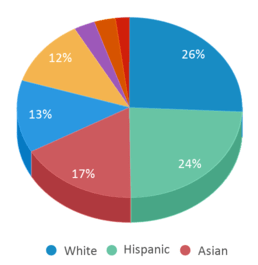
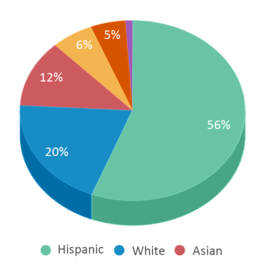
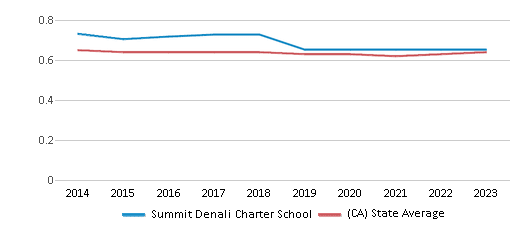
Eligible for Free Lunch
14%
54%
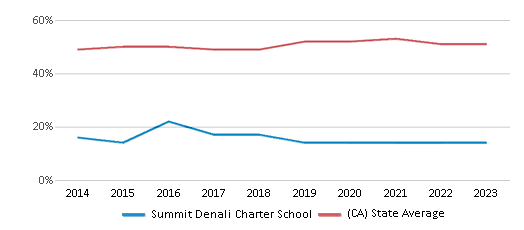
Eligible for Reduced Lunch (17-18)
9%
9%
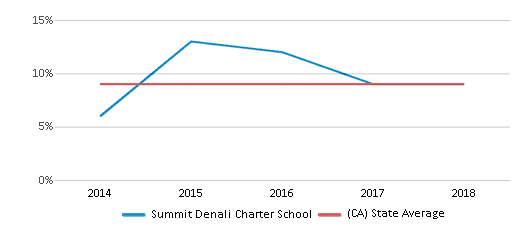
School Statewide Testing
School District Name
Sports
Total Sports Offered
3 sports
Sports
Basketball, Soccer, Volley Ball
Extracurriculars
Total ExtracurricularsTotal Extra-curric.
22 extracurriculars
ExtracurricularsExtra-curric.
Club or Organization:
Anime Club, Aquatic Engineering, Art Mentorship Club, Biking Club, Biology Club, Chess Club, Christian Club, Coding Club, College Library, Deipnosophist Club, Fashion/Design Club, Fundraising Committee, Future Medical Club, Hike/Run Club, Journalism, LGBTQ+ Club, Mock Trial, Music Club, Photography Club, Speech & Debate, Student Council, Volunteer Club
Anime Club, Aquatic Engineering, Art Mentorship Club, Biking Club, Biology Club, Chess Club, Christian Club, Coding Club, College Library, Deipnosophist Club, Fashion/Design Club, Fundraising Committee, Future Medical Club, Hike/Run Club, Journalism, LGBTQ+ Club, Mock Trial, Music Club, Photography Club, Speech & Debate, Student Council, Volunteer Club
Source: National Center for Education Statistics (NCES), CA Dept. of Education
School Notes
- Since opening in the fall of 2013 with a founding class of 6th graders, Summit Denali has served the diverse communities of Santa Clara County - from Palo Alto to San Jose.We believe that every student is capable of college success, that it takes character and academics to achieve that success, and that serving others is part of the joy and responsibility of success. These three elements are evident in everything we do, from project time to volleyball practice - for every student, every day.In 2020, we graduated our first class of seniors and are proud to share that college acceptances include schools like Stanford, MIT, all University of California schools, San Jose State, CalPoly, Princeton, and many more.Our middle school program is structured to respond to the unique and changing needs of adolescents, and readies our students for high school. Our program develops and builds skill sets, inspires engagement and creates lifelong learning habits. Students learn how to set goals, make plans, demonstrate their skills and knowledge, and reflect on their progress.Our high school program is college prep. Students continue with skill development. Students apply their acquired knowledge, skills, and habits to exercises that broaden and deepen their passions and prepare them for what they`ll encounter after graduation and in the world. Students participate in hands-on projects in class and eight weeks of expeditionary learning each year. Experiential learning exposes students to new career, volunteer pathways, and internships, while nurturing their sense of purpose. AP courses are required for all junior and senior students.Summit Denali is a countywide benefit charter school authorized by the Santa Clara County Board of Education. We are tuition free, open to all students, and currently enrolling incoming students in grades 6 through 12.
Frequently Asked Questions
What percent of students have achieved state testing proficiency in math and reading?
67% of students have achieved math proficiency (compared to the 39% CA state average), while 73% of students have achieved reading proficiency (compared to the 50% CA state average).
How many students attend Summit Denali Charter School?
660 students attend Summit Denali Charter School.
What is the racial composition of the student body?
26% of Summit Denali Charter School students are White, 24% of students are Hispanic, 17% of students are Asian, 12% of students are Two or more races, 3% of students are American Indian, 3% of students are Black, and 2% of students are Hawaiian.
What is the student:teacher ratio of Summit Denali Charter School?
Summit Denali Charter School has a student ration of 21:1, which is equal to the California state average of 21:1.
What grades does Summit Denali Charter School offer ?
Summit Denali Charter School offers enrollment in grades 6-12
What school district is Summit Denali Charter School part of?
Summit Denali Charter School is part of Santa Clara County Office Of Education School District.
Recent Articles

What Is A Charter School?
Explore the world of charter schools in this comprehensive guide. Learn about their history, how they operate, and the pros and cons of this educational innovation. Discover key facts about charter schools, including admission policies, demographics, and funding, as well as what to look for when considering a charter school for your child.

10 Reasons Why High School Sports Benefit Students
Discover the 10 compelling reasons why high school sports are beneficial for students. This comprehensive article explores how athletics enhance academic performance, foster personal growth, and develop crucial life skills. From improved fitness and time management to leadership development and community representation, learn why participating in high school sports can be a game-changer for students' overall success and well-being.

February 05, 2025
Understanding the U.S. Department of Education: Structure, Impact, and EvolutionWe explore how the Department of Education shapes American education, from its cabinet-level leadership to its impact on millions of students, written for general audiences seeking clarity on this vital institution.





